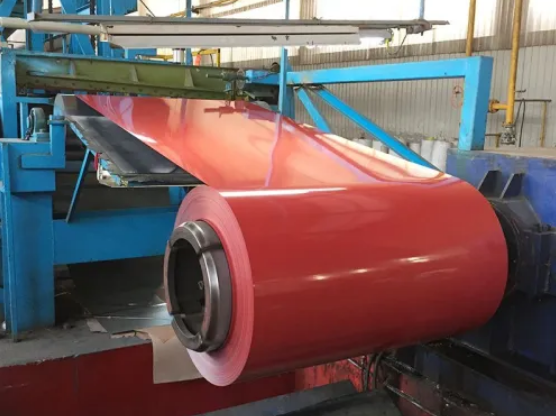Cold Rolled or Hot Rolled: Which Is Stronger
hot rolled steel and cold rolled steel, each exhibiting distinct characteristics suited for various applications. Understanding the disparities between these two types is crucial when selecting the appropriate rolled steel material for a project, as they significantly impact performance.
Hot Rolled Steel vs. Cold Rolled Steel
Rolling is a metal forming process utilizing a series of rollers to modify shape, improve uniformity, and/or enhance mechanical properties of materials. Rolled steel encompasses two main types: hot rolled steel and cold rolled steel, each exhibiting distinct characteristics suited for various applications. Understanding the disparities between these two types is crucial when selecting the appropriate rolled steel material for a project, as they significantly impact performance.
Hot-Dipped Galvanized Steel Coils(GI)
An Introduction to Hot Rolled Steel
Hot rolled steel refers to steel that has undergone the rolling process at a temperature exceeding its recrystallization point (typically 1700°F or higher). This process enhances the material's formability and workability compared to raw steel, facilitating easier handling in subsequent processing stages.
The hot rolling procedure commences with a large rectangular metal slab known as a billet. Initially, the billet is heated and compressed into a substantial roll. While still hot, it passes through a sequence of rotating rollers to attain the desired dimensions. In sheet metal production, the rolled steel is then wound into coiled rolls and allowed to cool. For other production applications, the processed material is cut into specified units and packaged accordingly.
Advantages of Hot Rolled Steel
Hot rolled steel provides numerous manufacturing benefits, including:
1. Lower cost: Hot rolled steel is generally more cost-effective than cold rolled steel due to reduced processing requirements.
2. Improved workability: The elevated temperatures during hot rolling result in greater formability and ease of shaping for the processed material.
3. Minimal internal stress: Through gradual cooling during the hot rolling process, the steel can normalize its structure, minimizing internal stresses.
Applications of Hot Rolled Steel
Due to its tendency to shrink slightly during cooling, hot rolled steel is often employed in applications where precise shape control is not critical. Common uses include:
1. Agricultural equipment
2. Automobile parts (e.g., frames and wheel rims)
3. Construction materials (e.g., I-beams)
4. Railroad equipment (e.g., tracks and railcar components)

color painted prepainted steel coil
An Introduction to Cold Rolled Steel
Cold rolled steel refers to hot rolled steel that has undergone further processing to enhance its dimensional and mechanical properties. In the cold rolling process, cooled hot rolled steel is passed through additional rollers at room temperature. As the material is no longer hot and malleable, a considerably higher level of pressure is necessary to shape it as desired. Although this process may be more labor-intensive and costly compared to hot rolling, it yields tighter dimensional tolerances and superior surface qualities.
Advantages of Cold Rolled Steel
In comparison to hot rolled steel, cold rolled steel offers several benefits, including:
1. Enhanced strength: Cold rolled steel can exhibit up to 20% greater strength than hot rolled steel, making it more suitable for high-stress applications.
2. Superior surface finishes: Components and products crafted from cold rolled steel typically feature a smooth and shiny surface devoid of rust and scale.
3. Increased precision: Unlike hot rolled steel, cold rolled steel maintains its dimensions after the forming process. This characteristic enables the creation of highly precise components that require minimal to no secondary processing.
Applications of Cold Rolled Steel
Cold rolled steel finds frequent use in applications demanding tighter tolerances and superior surface finishes. Common parts and products include:
1. Aerospace structures
2. Home appliances
3. Metal furniture
4. Strips, rods, bars, and sheets
5. Mechanical components
Key Differences Between Hot Rolled Steel and Cold Rolled Steel
As mentioned, the primary disparity between hot rolled steel and cold rolled steel lies in the temperature of processing. Hot rolled steel undergoes rolling above the material’s recrystallization temperature, while cold rolled steel is rolled below this temperature. Apart from this fundamental difference, there are several other distinctions between the two materials, including:
1. Surface quality: Hot rolled steel typically features rough edges and surfaces necessitating decarburization or other treatments for use in subsequent production operations. Conversely, cold rolled steel often boasts a shiny and smooth surface, making it suitable for immediate use in production operations.
2. Material hardness: Cold rolling results in steel with significantly higher strength and hardness compared to the steel produced through hot rolling.
3. Internal stress: The enhanced strength and hardness introduced by the cold rolling process also bring about greater internal stresses. These stresses must be relieved before further processing to prevent potential warping in the final part or product.
It's important to note that these distinctions between hot rolled and cold rolled steel are distinct from the technical specifications or grades used to categorize steel based on composition or physical characteristics. Regardless of metallurgical specifications or grade, steel can be either hot rolled or cold rolled.
When considering steel options for a project, it's crucial to discern which type of steel offers the requisite properties for the intended application. This understanding can prevent overspending on raw materials and streamline production processes.
